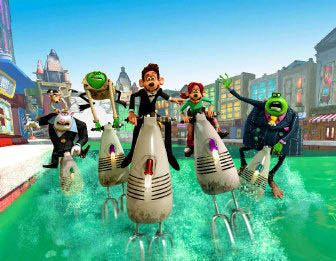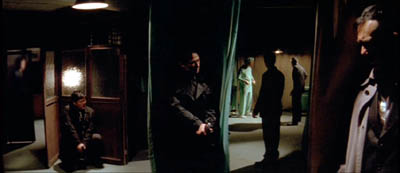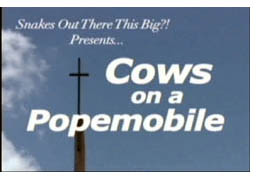Archive for the 'Hollywood: The business' Category
Running on almost empty

Three Kings (1999).
DB here:
Why, asks Sharon Waxman in the New York Times, have the much-touted directors of the 1990s slowed their output so drastically? Kimberly Peirce released Boys Don’t Cry in 1999; her second film, Stop-Loss, will come out this spring. Darren Aronofsky followed Requiem for a Dream (2000) with The Fountain, which hit screens last fall. Paul Thomas Anderson’s Punch-Drunk Love is over four years old. David O. Russell, Spike Jonze, David Fincher, Baz Luhrmann, and several others of their generation have, Waxman points out, “taken long hiatuses before stepping back up to the plate.”
Immediately, exceptions spring to mind. Some filmmakers who built their careers in the 90s are pretty prolific. Soderbergh is the prime instance; he sometimes releases two movies a year. Christopher Nolan has given us several one-two punches: Memento in 2000 and Insomnia in 2002, Batman Begins in 2005 and The Prestige in 2006. James Mangold is now doing postproduction on 3:10 to Yuma, his seventh movie since 1995. Kent Jones reminds me that Richard Linklater has finished twelve features in under 16 years!
Still, the slow pace of some heralded filmmakers is noteworthy. Waxman’s explanations, culled from interviews with Hollywood cognoscenti, intrigue me. Probably no one explanation will provide the answer, but it’s worth thinking about the many forces at work. I’ll run through Waxman’s five main points, commenting on each. Then I’ll toss in a few of my own.
1. Filmmakers undergo closer scrutiny and quicker judgments than at earlier times. Critics, audiences, and studios pounce on every failure, and with investments becoming more precarious, a single weak showing can push the director down the list.
Seems plausible to me, given the dumping of Shyamalan after Lady in the Water. Shyamalan is ambitious in his storytelling aims, trying to turn genre movies into art movies/ event movies à la Kubrick. Unlike Kubrick, he’s not winning a secure place as a person you want to be in business with. Strange as it sounds, a director who has earned over a billion dollars at the global box office is making the rounds trying to sell his newest idea.
2. Filmmakers are pressured to write lucrative scripts rather than direct questionable projects, or to direct sure-fire franchise hits (e.g., Bryan Singer and Superman and X-Men).
Partly true. But a producer friend commented to me that a lot of indie filmmakers whom he meets sincerely want to direct big films. Bryan Singer, who admires Spielberg, hasn’t made a secret of his desire to be a mainstream filmmaker. Aronofsky was long involved with Frank Miller on a new Batman, and Karyn Kusama moved from Girlfight (2000) to Aeon Flux (2005).
3. An overindulgent studio culture lacks strong executives who would challenge precocious filmmakers to extend themselves.
Put aside the fact that this explanation is somewhat opposite to the previous one. It’s hard to claim that today’s executives are too complaisant; surely one reason for the delays in output is resistance from the studios’ to directors’ ideas. If executives might be reluctant to derail a project, certainly stars are willing to do so. Once a picture enters production, however, it is more difficult for today’s executives to curtail the pricey directors to the extent that classic studio-era moguls could. The director’s demand for final cut, for instance, is still a powerful chip in the game.
4. The 90s directors might not be capable of dealing with the big issues of a post-9/11 world. Waxman writes: “Perhaps Quentin Tarantino, child of the video culture, feels at a loss when faced with the war in Iraq and global terrorism.”
It might be too early, though, for filmmakers to come to an initial understanding of this ongoing crisis. The major films treating Vietnam appeared some years after we pulled out: Twilight’s Last Gleaming, Coming Home, The Deer Hunter, Apocalypse Now, and so on. Moreover, not all films need to deal with big issues, at least directly. What aspects of American politics did Pulp Fiction and Memento address?
5. There’s no shared creative community, in which filmmakers help and compete with one another. Three currently successful directors from Mexico, Alejandro Gonzalez Inarritu, Guillermo del Toro, and Alfonso Cuaron exemplify how a cadre of friends can offer frank criticism and spur one another on.
Oddly enough, James Mottram’s book The Sundance Kids: How the Mavericks Took Back Hollywood maintains that just this sort of community exists among several 90s directors. The book opens with a meeting of the Pizza Knights, a cadre of young filmmakers who gather every month to watch 70s classics. The group includes Fincher, Jonze, Anderson, Peirce, and Payne (p. xv)—the very directors whom Waxman lists as surprisingly unproductive. They may not bond with older directors, but according to Mottram they constitute a pretty tight group.
Some other possibilities strike me.
*Maybe this particular batch of directors is just an easygoing demographic. Tarantino took his time moving from Jackie Brown (1997) to Kill Bill: Volume 1 (2003). The Virgin Suicides came out in 1999; does Lost in Translation (2003) look like a movie it took four years to make? They don’t call it Gen X for nothing.
*We should consider the possibility of burnout. Dwight Macdonald once remarked that the stress of making one film is much more intense than painting a picture or even writing a novel. It’s deeply exhausting on many levels. MacDonald speculated that across their careers filmmakers are likely to slow down or burn out or just make weaker films. We can all think of exceptions (Manoel de Oliveira is still turning out extraordinary films at age 98), but filmmaking does require a lot of energy. This might be especially the case if a director achieves early success, because the demands of each new project can escalate before the director finds her or his comfort level.
*Making just one film takes a long time. Aronofsky’s years of effort to produce The Fountain are well-known, as are Luhrmann’s problems with a life of Alexander the Great. Even a midrange project might be years in preparation before it finds backing. Once the project is approved, there can be months of preproduction, several months of shooting, and over a year of editing. To launch any big film, the director and stars will be meeting the press, traveling to foreign markets for promotional events, and preparing the DVD supplements. A lot of this will be happening just before or soon after the film’s release, slowing progress on the next project. The avalanche of such demands can only increase your respect for the stamina and multitasking abilities of Spielberg and Soderbergh.
Hong Kong and Japanese directors can be more prolific because the industry is more small-scale and there isn’t the same demand to promote the film afterward. Johnnie To turns out two films a year, Miike Takeshi more than that. They get to develop a body of work that, despite its ups and downs, has a texture lacking in one- or two- or three-shot wonders.
*The market has consolidated. An earlier wave of indie directors like John Sayles, Spike Lee, Gus Van Sant, Oliver Stone, and the Coens faced a fairly diverse marketplace. Their films benefited from the emergence of home video, overseas television outlets, mini-majors, and small but fairly well-funded distributors. They quickly built up individual identities–brands, if you like–that still give them some clout with studios and make them more productive than the group Waxman profiles. Although there are many distributors on today’s landscape, most are tiny. The younger indie auteurs, I think, face a more homogeneous system, with studios and their boutique divisions controlling a larger share of funding and more distribution outlets. There are fewer cozy niches for small, quick projects.
*Finally, there’s critics’ hype. Perhaps too much was expected of these rather untried directors. If you’re called a genius on your first or second outing, how can you top that? Consider these heroic descriptions:
With their films, the rebels of the 1990s shattered the status quo, set new boundaries in the art of moviemaking, and managed to bend the risk-averse studio structure to their will. They created a new cinematic language, recast audience expectations, and surprised us—and one another.
Quentin Tarantino, the rabble-rousing writer-director of Reservoir Dogs and Pulp Fiction . . . very early in the decade broke every rule in moviedom.
The movies of the new rebel auteurs . . . played with structure, wreaked havoc with traditional narrative form, fiddled with the film stock, and ushered in the whiplash editing style true to a generation of video game children.
In the perspective of film history, these claims are sheer nonsense. (I try to show why in The Way Hollywood Tells It.) They aren’t good prophecy either. I ♥ Huckabees and The Life Aquatic with Steve Zissou didn’t exactly bend the studios to their directors’ will. In any event, such guff overheats the creative climate. Filmmakers aren’t granted a more gradual and modest exploration of their strengths and limits. When they fail, they may fail spectacularly.
By the way: the author of the souped-up passages I just quoted? None other than Sharon Waxman. (1)
(1) Sharon Waxman, Rebels on the Backlot: Six Maverick Directors and How They Conquered the Hollywood Studio System (New York: HarperCollins, 2005), x-xi.
PS Monday: Based on some intriguing box-office data, Karina Longworth gives a sharper-tongued rebuke to Waxman in her lively post here.
Too many toons? Then why are they making so much money?

Kristin here—
Back in my December 10, 2006, entry, I discussed some reasons why CGI animated features often seem better than their live-action competition.
In passing I mentioned that industry news sources were discussing whether there were too many CGI films made last year. “Studio executives and commentators continue to debate whether there are now too many CGI films coming out. Indeed, the November 24 issue of Screen International says, ‘Much has been made this year of the seeming over-saturation of studios/computer-generated titles, with critics and analysts pointing to growing movie-goer apathy.’”
I realize that industry pundits have to have something to write about at year’s end. Unlike the critics, they don’t have the ten-best lists and who-will-win-the-Oscar options, so they assess box-office trends. One year indies suddenly are in, the next year the big sequels have surged back, and the next year the indies are back. To read the trade papers, one would think that trends come in neat one-year cycles. Maybe studio executives plan their upcoming films according to these supposed trends, but films being greenlit now will only appear years in the future. By then the cycles will have turned over and over.
The “too many toons” issue looks to me like a tempest in a teapot. If you look at the various box-office lists for 2006, CGI animation did better proportionately than live-action films did.
Let’s start at the bottom. The December 25-31, 2006 issue of Variety ran Nicole LaPorte’s “2006: H’w’d diagnoses its duds.” (I’d link to the online version, but it seems inexplicably to have disappeared from Variety.com.) There she talked about the 10 biggest failures of the year. Despite the title, the diagnosis and choice of films was done not by studio employees but by an “inhouse Variety poll.” To be included, films had to be relatively big-budget items that could plausibly have been hits on the basis of the track records of their directors, stars, or source material. (e.g., Lady in the Water, Poseidon, A Good Year).
One animated feature made the list: Flushed Away. I have already expressed my liking for this film and made some suggestions about why it undeservedly failed. Presumably it is a coincidence that DreamWorks’ head of marketing is leaving the company to set up on her own. She had presided over many hits for DreamWorks, and her new firm will continue to work with its releases. Still, the Variety story announcing the move refers to the lackluster performance of Flags of Our Fathers but does not mention Flushed Away or earlier Aardman films.
OK, so one of ten flops as designated by Variety staff members was a CGI feature. Nine of them are live-action films.
Now let’s go to the top of the list. The ten highest domestic box-office grossers in 2006 included four CGI hits: Cars, #2, Ice Age: The Meltdown, #7, Happy Feet, #8, and Over the Hedge, #10. On the worldwide chart, these four films rank high as well: Ice Age: The Meltdown, #3, Cars, #5, Happy Feet, #10, and Over the Hedge, #11. In the domestic market, 6 other toons make the top 100. So, 4 out of 10 toons are in the top ten, while 6 out of 90 live-action films make that short-list. I’m no math whiz, but that looks like 40% versus 6.6% to me.
Of course, as I pointed out back in the infancy of this blog, grosses aren’t the best measure of success. How much a film cost obviously determines how profitable it will be. Casino Royale, the #9 domestic box-office pull in 2006, took in $164 million—it is unanimously hailed as a hit, but it cost a reported $150 million to make. There’s also the factor of “prints and advertising”: how much it costs to order thousands of copies of a film and how much is put into the various forms of publicity. As I noted, P & A costs are seldom announced.
Recently, however, Kagan, a company with access to proprietary industry figures, put out its list of the 10 most profitable films of 2006. (Only films that “open wide” are included. That used to mean something like 500 or 600 theaters, but as more films come out on thousands of screens, the term has become pretty vague.) Kagan does factor in P & A expenditures alongside the filmmaking budget to determine a figure for a film’s total costs. It also has a formula to calculate the total income from all major forms of distribution: not just theatrical box-office, but DVD and the various other video and TV income for a film. The result is about as accurate a notion of profitability as we outside the industry are likely to get.
Going by Kagan’s reasonably reliable profitability figures, how do animated features stack up? We all know that CGI is expensive. A live-action feature that depends very heavily on computer trickery might spend as much as half its budget on special effects.
Surprisingly, CGI animation can be profitable. Kagan pronounced Ice Age: The Meltdown the most profitable film of 2006. With total production, marketing, and other direct costs of $256.4 million and an estimated $1.05 billion worldwide gross from all distribution channels, the proportion words out to 4.11 on the “Kagan Profitability Index.” (A film generally is assumed to be profitable if it achieves a KPI rating of 1.75 or more.)
Three other animated films made the top ten on the Kagan KPI list: Cars was the 8th most profitable film, Over the Hedge the 9th, and Happy Feet the 10th. These figures are all the more remarkable when one considers that a high proportion of tickets sold for animated films tend to be at the lower children’s admission prices.
The real question isn’t really whether there are too many animated features coming out. It’s actually how large the G and PG markets are. Live-action films come in all ratings, so they are not all competing with each other. R-rated horror films compete with other edgy teen-oriented movies but not with family-friendly holiday movies. Toons tend to compete with each other, but they also compete with G and PG live-action films. Flushed Away was not done in because it opened on the same weekend as another CGI toon. It presumably sank partly because it was released on the same day as The Santa Clause 3.
In 2006, live-action films for children didn’t do as well among domestic grossers as animated ones did. Night at the Museum was #5 with $205 million, but the next highest film of this type, The Santa Clause 3, took in $84 million to end up at #22.
Bottom line—and that’s what we are talking about here—there doesn’t seem to be a glut of animated films so far. Let’s see what Shrek 3 and the other CGI toons of 2007 lead the pundits to diagnose a year from now.
Updates and outtakes (in which we try, perhaps in vain, to catch up with ourselves)

Exiled
Kristin writes:
“The Hobbit Film: New Developments” (January 13, 2007)
In this entry I discussed Bob Shaye’s recent claim that Peter Jackson would never get a chance to direct The Hobbit for New Line. I mentioned that one of the factors involved in the negotiations about who would direct is that the production rights will eventually revert to producer Saul Zaentz. I didn’t know the length of the option on those rights, which New Line currently holds. The January issue of the fantasy/sci fic magazine Locus says that the rights will revert to Zaentz in 2009.
Zaentz had owned the rights since the mid-1970s and sold them to Miramax in early 1997. Miramax had the two-film version of The Lord of the Rings in pre-production for about 18 months and then sold the rights to New Line in August of 1998. I don’t know what the source of Locus’ information is, but a twelve-month option would seem pretty plausible.
If that information is correct, New Line only has about two years to get the actual making of the film underway. It takes years for any big film to lumber into production in Hollywood these days, so the studio doesn’t have a lot of room to wiggle.
“By Annie Standards” (December 14, 2006)
Here I talked about methods for publicizing animated features. One way, I suggested, would be to foster audience interest in the various animation awards other than the Oscars. I remarked, “Under Academy rules, only three animated features can be nominated in any year unless sixteen or more such features are released that year. Then the number of nominations jumps to five, but so far that hasn’t happened. It may finally happen this year, if all sixteen features currently under consideration qualify under Academy rules.”
Close, but not close enough. On January 11, Variety announced that one film, Luc Besson’s Arthur and the Invisibles, had been disqualified as an animated feature. To qualify, a film must have at least 75% animated footage, and Arthur has too much live action.
With the number of qualifying features down to fifteen, only three can be nominated. Probably Cars will win, as I predicted in the original entry. It just won the Golden Globe in the newly established Animated Film category.
“Snakes, No, Borat, Yes: Not All Internet Publicity Is the Same” (January 7, 2007)
Here I suggested some reasons why Snakes on a Plane failed at the box office and Borat: Cultural Learnings of America for Make Benefit Glorious Nation of Kazakhstan succeeded, despite the fact that both garnered considerable fan-generated publicity on the internet. I mentioned that Sacha Baren Cohen had appeared on talk shows in character as Borat rather than in persona proper: “Each appearance by “Borat,” supposedly there to talk about the film, ended up being a hilarious performance by Cohen, ad-libbing on everything around him—the chairs, the coffee mugs, the cameras, the audience. Spectators ended up with one impression about the film: it was about this incredibly funny guy doing incredibly funny things.”
Trying to correct the widespread assumption that Borat was an improvised film, the January 8-14 issue of Variety ran a story about how Cohen worked with three scriptwriters, Peter Baynham, Dan Mazer, and Anthony “Ant” Hines: “The scribes even concoct Cohen’s dialogue for his promo appearances on ‘The Tonight Show’ and ‘Live With Regis and Kelly.’” Although Cohen presumably ad-libs to meet specific circumstances of each talk show, the publicity appearances are even more controlled by Cohen than I had assumed.
I also remarked that it is difficult to judge the degree to which the film manipulated the scenes of Borat’s encounters with real people. Especially in terms of editing and sound techniques, there was clearly much opportunity for this manipulation. The same Variety story goes on to say, “Much of the script had to be altered depending on how situations unravel. This means the writers ultimately end up producing the equivalent of multiple scripts, much of which ends up on the cutting room floor.” I’m not sure how chunks of scripts can end up on the cutting-room floor, but the point is that the filmmakers were carefully stitching the “documentary” scenes together on the script level and presumably would do so through stylistic means as well.
David writes:
Back to the Hotel
The Uchoten Hotel (aka Suite Dreams, blogged here) has acquired yet another English-language title: Hotel Avanti. It made it to #93 on Variety‘s list of the world’s 100 top-grossing films, with $51 million box office in Japan and none yet recorded overseas.
Speaking of Variety‘s list, the highest-grossing non-English language item turns out to be Bong Joon-ho’s Korean hit The Host (#59 at $84 million), due out in the US any month now. Only ten non-English-speaking films made the top 100, and of those, three were European (including Volver) but all the rest were Asian: Chinese (Fearless), Korean (The Host and King and Clown), and Japanese (Tales from Earthsea, Umizaru 2 Limit of Love, Hotel Avanti, and Japan Sinks–no rude remarks, please).
The entire list is in the 15-21 January hard copy of Variety, p. 15, but evidently it isn’t yet available on the paper’s site.
More on Johnnie To
In an earlier blog I praised Johnnie To as a director who shot and cut PTU smoothly and crisply. I waited through the fall, hoping somehow to see To’s latest, Exiled, on the big screen at one festival or another. No such luck. So last night I broke down and watched the DVD. Making full use of the widescreen format, To shows that classic technique can be at once rigorous and imaginative.
Exiled was more visually engaging than any US film I can recall last year, including Miami Vice. It immediately became my Best Film of 2006 That I Saw in 2007. (Runner-up: Children of Men.) I visited Milkyway while the film was being shot, and I hope to blog about the result in a future entry.
At Large on the Internets
On this very site, I’ve posted a new essay on action movies.
Annie Frisbie interviewed me for the Zoom-In podcast here. Annie is also blogging/reviewing Sundance films here.
Fox Independent visited Madison and posted videos on its site. The setup and the interview with filmmaker and teacher Erik Gunneson are here. An interview with me is here.
Snakes, no, Borat, yes: Not all Internet publicity is the same

Kristin here–
This past summer I had my first experience of being quoted as a pundit in a major newspaper. The Los Angeles Times was planning a story on the internet buzz around Snakes on a Plane and more specifically around the fact that some of that buzz had actually influenced New Line to change the film.
In late July I had completed the final revision and updating on The Frodo Franchise. Two chapters cover the official and unofficial internet publicity for The Lord of the Rings. The last thing I had added to those chapters was a reference to the Snakes internet phenomenon—which was still ongoing, of course, since the film was not released until August 18. The connection is closer than it may appear, since New Line distributed both films.
Dawn Chmielewski, of the LA Times, got wind of my work on fans and the internet. She called me, and we had a pleasant 40-minute conversation. The result was one pretty uncontroversial statement from me near the end of the story, describing how studios have a mixed attitude toward fan sites on the internet: “It is a phenomenon where the studios are having to keep a delicate balance between, on the one hand, wanting to use this enormous potential for publicity, and on the other hand have to control over copyrighted materials and over spoilers.”
This story was part of the huge amount of attention paid to the Snakes phenomenon, with Brian Finkelstein, webmaster of the main fan site, Snakes on a Blog, widely quoted about how New Line had cooperated with him and even invited him to LA for the premiere. One of the main points of interest to the media was that New Line had added a line of dialogue that had originated on a fan site for Samuel L. Jackson’s character. The studio also added some sex and gore, moving the film’s rating from PG-13 to R.
Fans’ influencing films was not entirely new by this point. After The Fellowship of the Ring came out in 2001, two fans elevated a non-speaking elf extra from the Council of Elrond to fame by dubbing him “Figwit” and starting a website devoted to him. As a salute to the fans, the filmmakers brought the extra back and gave him one line to say in The Return of the King, where he is credited as an “Elf escort.” That phenomenon, however, didn’t get much notice beyond fan circles. The Snakes revisions got far more attention.
Much was made of the fact that industry officials were eager to see whether wide internet buzz—especially when covered by mainstream news media—would translate into boffo box-office figures. As we all know by now, Snakes was a deemed a failure. New Line said that its opening gross was typical for a low-budget genre film. Snakes cost a reported $33 million. Ultimately it took $34 million in the domestic market and a total of just under $60 million internationally. I suspect that New Line spent a great deal more on advertising that it ordinarily would have, hoping in vain to expand the enthusiasm. The film’s box office takings would certainly not bring in a profit, but doubtless New Line hopes for better things on DVD. That DVD was released on January 2, so no sales figures are available yet, but the widescreen edition is doing reasonably well at #19 on Amazon.
 The film’s disappointing ticket sales led to questions. Why would fans spend so much time on the internet and generate such hype and then not go to the film? After all, fans created parody posters, music videos, comic strips, and photos on their sites, as well as designing T-shirts and other mock-licensed products. (The DVD supplement “Snakes on a Blog” presents a generous sampling of such homages; see also Snakes on Stuff.com.) And if that much free hype—even aided and abetted by the studio—didn’t translate into ticket sales, was the internet all that useful for publicizing films?
The film’s disappointing ticket sales led to questions. Why would fans spend so much time on the internet and generate such hype and then not go to the film? After all, fans created parody posters, music videos, comic strips, and photos on their sites, as well as designing T-shirts and other mock-licensed products. (The DVD supplement “Snakes on a Blog” presents a generous sampling of such homages; see also Snakes on Stuff.com.) And if that much free hype—even aided and abetted by the studio—didn’t translate into ticket sales, was the internet all that useful for publicizing films?
Of course fan sites had already proven their worth for New Line’s own Austin Powers: Man of Mystery and Lord of the Rings. Other films had benefited from free fan labor and enthusiasm. Famously The Blair Witch Project became a massive hit primarily because of the internet. But anytime a hitherto dependable formula results in even a single failure, the studio publicity departments go into a tizzy of doubt. It’s true of genres, stars, and just about any other factor you can name. Snakes fails, so maybe the internet isn’t that powerful a publicity force.
Borat: Cultural Learnings of America for Make Benefit Glorious Nation of Kazakhstan came along to confuse things even further. It, too, had a huge fan presence on the internet. In this case, the main activity was the posting of clips on YouTube. Well before the film was released on November 3, deleted footage and some scenes from the film were showing up. There were about 2000 by then, and as of yesterday a search for “Borat” on YouTube yielded 6,293 items.
It came to be a joke on the internet: “What is the difference between Google and Borat? The latter knows how to make money from YouTube.” (“Borat” was recently reported to be one of the top search terms on Google in 2006.) Webmasters and chat-room denizens who were already fans of Sacha Baron Cohen from Da Ali G Show, where the Borat character originated, promoted the film. The internet buzz probably led to more coverage of the film in mainstream infotainment outlets than would have otherwise occurred.
Borat’s reported budget was $18 million. To date, it has grossed $126 million domestically and a total of $241 million worldwide.
The timing of the two events triggered much press coverage and show-business hand-wringing. What did it all mean? Is the fan-based sector of the internet good for films or not?
This isn’t some idle question as far as the industry is concerned. Twentieth Century Fox wisely encouraged all the Borat uploaders at YouTube. Far from threatening to sue over copyright, they leaked footage. Then, however, shortly before the film’s release, audience research (that highly dubious tool in which studios put such faith) revealed that many members of the public had never heard of Borat. What to do? At the last minute Fox cut back the number of theaters in which the film would be shown. Did anyone else in the world think that was a good idea?
Back on November 11, with Borat freshly successful and speculation about internet coverage rife, I promised to explore how the two films differed when it came to internet hype and success. That would be possible to do without seeing either film. I saw both, though. Like many others, I watched Borat in a theater and Snakes on DVD.
Others have offered reasons for the difference. On NPR, Kim Masters made some plausible observations. Snakes, she points out, “was a film with a very broad concept—Samuel L. Jackson battles snakes on a plane. The buzz took off on thousands of Web sites as the film became the butt of many jokes. The problem is that the movie wasn’t really meant to be that funny. Borat, on the other hand, is meant to be funny.” True enough. In fact, Snakes has a weird mixture of tones, starting off with a highly non-humorous scene of a gangster killing a man with a baseball bat. It goes on to interject funny moments in the midst of grim ones in a seemingly random way.
Moreover, Masters claims, the buzz for Snakes “took off too fast” and in the wrong places. The sites making all the jokes and parodies weren’t the same ones that horror fans frequent, and the humor may in fact have created a negative reaction among what would ordinarily have been the film’s target audience. Borat had no such problem. Fans of comedy and especially of Cohen spread the word to likeminded fans through what is termed viral marketing in the publicity business.
All true, and yet, having studied Lord of the Rings fan sites for a long time, I think there was another crucial factor that never occurred to the anxious studios. That factor was what the fans were doing with the films on their websites, in chat rooms, and on YouTube.
Many popular films, especially in genres like fantasy, science fiction, action, and horror, generate fanfiction, fanart, spoofs, and other creative responses. Snakes on a Plane offered the inspiration for all sorts of clever writing and drawing and videomaking through its title alone. As was pointed out over and over, from that title and the casting of Jackson, everyone knew what the film would be like. It could be parodied without even being seen. Indeed, I suspect that after months of posting and mutually enjoying hundreds of amusing riffs on “Snakes on a Plane,” many fans realized that they could never have as much fun watching the film as they had playing around with its title and concept. It had never been the movie itself they were really interested in.
Borat’s full, unwieldy title was also an attention-getter, but no one could possibly predict much about the film from it, let alone parody it. Here the focus was primarily on how funny Cohen was as Borat and how funny the film was going to be. What circulated were samples that seemed to prove exactly that. People would go to this film and have more fun than they could possibly make for themselves by messing around on the internet with its title. The words “snakes on a plane” could inspire just about anybody with a creative bone in their body, but only Cohen could do Borat.
Print and broadcast media spread the same message. For Snakes, they had zeroed in on the internet coverage and stuck with that. End message: there is a lot of fan attention being paid to a rather silly-sounding film. For Borat, they had Cohen appear as an interviewee.
Cohen brilliantly manipulated the infotainment outlets, especially the chat shows, by appearing in character as Borat. As the film’s release approached, Cohen was a hot property, a ratings booster. Talk-show hosts and soft-news reporters presumably couldn’t alienate him by insisting that he speak as himself. Maybe they didn’t want to. As a result, three things happened. First, the endlessly talkative Borat dominated each interview. On The Daily Show, the ordinarily in-charge Jon Stewart was totally unable to control the situation and frequently cracked up, once badly enough that he had to turn his back on the audience momentarily.
The second result was that each appearance by “Borat,” supposedly there to talk about the film, ended up being a hilarious performance by Cohen, ad-libbing on everything around him—the chairs, the coffee mugs, the cameras, the audience. Spectators ended up with one impression about the film: it was about this incredibly funny guy doing incredibly funny things.
Third, there could be no discussion of the less savory aspects of Borat, the ones that mostly surfaced after the film was already a hit. These included allegations that people had been manipulated by false claims into signing consent forms and “performing” in the film. One has to suspect that when Cohen was explaining his project to them, he may have appeared as his own rational self and not in the wild-and-crazy persona of Borat. The stylistics of the film itself betray many points at which encounters with real people could have been manipulated. Who knows what the crowds at the rodeo where Borat butchers the national anthem were actually reacting to? None of their responses is ever visible in the shots of Borat. How many non-bigoted interviews were thrown out for every bigoted one that could be used?
The point is, though, that the interviews were like the internet clips, furnishing more evidence of how entertaining the film would be. Borat could provide a sort of creativity that was all his own, and fans could never imagine it ahead of seeing the film or create a more fun version of it themselves. Many, many of the people who posted or read stuff about Borat on the internet went to the film.
Ultimately the studios have yet to emerge from their early love-hate relationship with fan-generated publicity on the internet. They dread the early posting of bad reviews and crave good ones, naturally. But they still seem to believe that most other online publicity means the same thing: eyeballs on monitors should equal bottoms in theater seats. Publicists have not yet grasped that fans don’t go to the web just to talk about films and learn about films. They do things with films, and different films inspire different sorts of activities. Those different activities may or may not mean that the fan ultimately wants to see the film itself.

In most cases they probably do end up seeing the film. Snakes on a Plane is most likely an aberration, as Blair Witch was. But Snakes does prove one other thing. Fawning attention paid to the webmasters and bloggers who launch these unofficial campaigns is no guarantee of success. The “Snakes on a Blog” supplement displays some interesting aspects of New Line’s wooing of the main fans involved in the online hype. The documentary seems to have been made at just about the time Snakes was released. It ends with the bloggers, by invitation, on the red carpet at the Chinese Theater for the film’s premiere and later at the bloggers’ party put on by New Line at a bar. The whole tone is very enthusiastic about the internet’s impact on the film’s success; there is no sense that the film will disappoint and raise doubts about the value of fan publicity. There is also the implicit suggestion that fans starting future film-related blogs might get similar encouragement and hospitality from studios.
Clearly no amount of studio cooperation and attention to fans’ interests will make a film succeed if the right blend of ingredients isn’t there. Nevertheless, fans’ enthusiasm and willingness to spend great amounts of time, effort, and even their own money to create what amounts to free online publicity for films is of incalculable value to the studios. Yet for the most part those studios are still making only grudging, limited use of this amazing resource. The resentment they garner from fans as a result may be squandering part of that resource’s potential.
Gradually, though, the studios are giving up their policy of stifling the fans by making vague threats about copyright and trademark violations. If they go further and actually learn how fans use all the amazing access the internet has given them, maybe movie executives can relax and recognize the obvious answer to the current debate: Yes, fans on the internet are good for the movie business.













